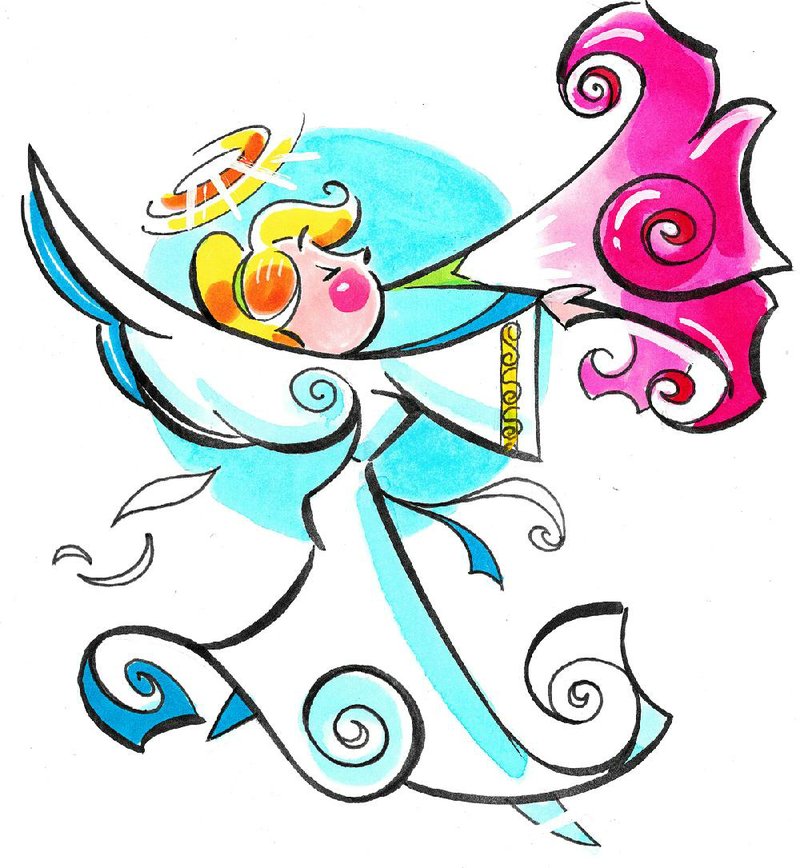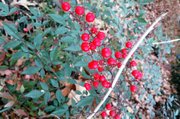DEAR READERS: The recent picture of the Brugmansia (angel's trumpets) brought a lot of email responses. Here are two of the questions:
• "I bought a tri-colored angel trumpet plant about four years ago. It dies down in winter but grows fairly tall and bushy in the summer but has never bloomed. I live in Conway. Any suggestions on how to get it to bloom?"
• "The Brugmansia in Dec. 2 Democrat-Gazette is the biggest I have ever seen. I assume it stays outside each winter in south Arkansas. I keep mine over the winter in the basement, but trim them down somewhat. If I don't trim them, the growth is spindly. They never get very much larger each year. Should I re-pot each year to promote larger size plant?"
A You do have a choice of leaving Brugmansia in the ground or in a container in central and southern Arkansas, and I even have seen gardeners in Northwest Arkansas who have it surviving outdoors -- planted in the ground -- but if you read about these plants, you know that should not be the case. In a container, the plant would need some protection in the winter in most of Arkansas, as the root system will get colder in a pot than in the ground. By taking it indoors, you also allow the plant to grow larger because it will not die back to the soil line, which happens with all the Brugmansia planted outdoors. Containerized plants need to be re-potted every year. They get root-bound quickly, and if they are root constricted, they will not grow much. Planted and containerized Brugmansia need bright light to stay full and bushy. Full morning sun or bright indirect sun with some shade in the afternoon is ideal. Brugmansia are heavy feeders, so keep fertilizing all through the growing season.
Q I don't have the article on care for the beloved hydrangea. Can you tell me again what I should use to prevent this invasion of leaf spots?
A I daresay you will not find a hydrangea that didn't have a few leaf spots at the end of the growing season. Cercospera leaf spot is a common problem on hydrangeas and, thankfully, most plants don't suffer any permanent damage from the fungus. If your plants are attacked early in the season, then a preventive program would be necessary. But if the spots don't occur until late summer/early fall, I would not be concerned. Rake and destroy the leaves as they fall so you start off the spring season with a clean slate. If the disease starts earlier in the year for you or is affecting blooming, some fungicides can be used as a preventative. A fact sheet on the subject is at uaex.edu/publications/pdf/FSA-7570.pdf
Q Right now my nandina plants are beautiful, with bright red berries. I have a neighbor who has told me that I need to dig them up because the berries are poisonous to birds. My grandmother grew this plant and she had also fed the birds, and I never saw any dead birds. Are the new varieties more toxic than the old-fashioned ones?
A If you do a search on the internet you will get a lot of hits about the toxicity of nandina berries and that they are deadly to birds -- particularly cedar waxwings. I think we all need to step back a bit and look at the problem. The incident that generated all this uproar happened in April 2009 in Georgia. Many cedar waxwings were found dead in a yard in Thomas County, Ga. Five birds were examined, and their bodies were full of nandina berries, and it was determined they died from cyanide poisoning. Nandina domestica berries contain cyanide and other alkaloids, but so do at least 2,000 other plants. Certain weather conditions such as huge swings in temperature or drought conditions can increase the concentration of cyanide in some plant species. Weather during late winter and early spring in the study area might have favored increased cyanogenesis in the nandinas. The combination of the weather, along with the feeding habits of the cedar waxwings is believed to have caused the incident. Because of their voracious feeding, the birds have eaten toxic doses of Nandina domestica berries. At any time of year, cedar waxwings can appear suddenly, gorge themselves on berries, and move on; a flock of waxwings can strip a tree of berries in a matter of hours. In 2010, hundreds of dead cedar waxwings were found on a highway in Texas after eating overripe blueberries. According to allabout birds.com, "because they eat so much fruit, cedar waxwings occasionally become intoxicated or even die when they run across overripe berries that have started to ferment and produce alcohol." Toxicity associated with nandina was not previously reported in cedar waxwings. I do not believe new species contain any more cyanide than older varieties. In fact, many of the new cultivars of nandinas are fruitless -- they do not bloom or set berries. While I hate to lose any birds, I don't think we need to remove the nandinas. Cutting off the berries in midwinter could prevent a problem. It also will solve another problem with nandina, which is that is becomes invasive since many birds eat the berries and drop them, causing them to spread into parks and natural areas.
Janet B. Carson is a horticulture specialist for the University of Arkansas Cooperative Extension Service. Write to her at 2301 S. University Ave., Little Rock, Ark. 72204 or email her at
jcarson@arkansasonline.com
HomeStyle on 12/16/2017

